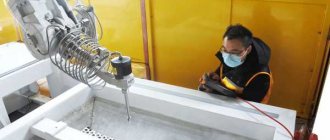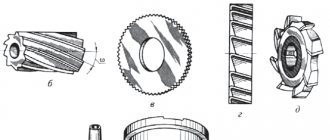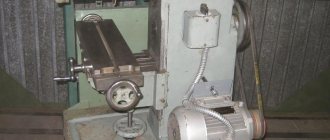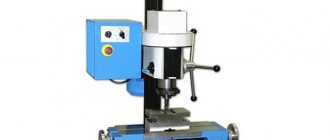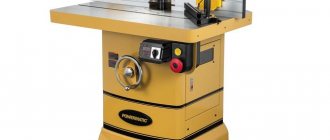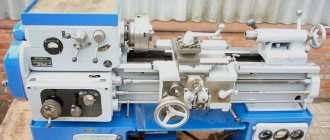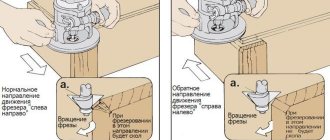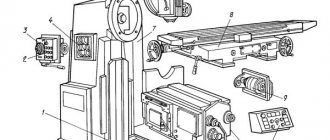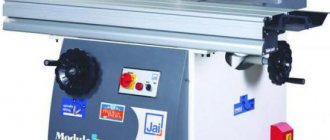Widely represented on the modern market, small-sized CNC milling machines, characterized by compactness and high functionality, are especially popular with companies that produce various products in small batches. It is convenient to use such machines to equip a home workshop, if it often involves processing metal workpieces, as well as other materials.
Small-sized CNC milling machine - compact and functional
Scope of use
CNC drilling and milling machine
Tabletop machines are equipped with a full-fledged numerical control system. They are used as educational equipment in universities and colleges, and work in laboratories, research centers, service stations, and small repair shops.
The CNC machine performs the following operations:
- drilling;
- countersinking;
- milling;
- hole designations;
- cutting;
- engravings.
In addition to the standard control program, the milling machine works with graphic and design programs that are easy to use. As a rule, CNC skills appear at the end of the first day of use. The equipment is connected to the computer via a USB port.
Vertical feeding equipment produces 2D and 3D parts from soft metals, wood of various densities, polymers, plywood, balsa wood, linoleum, textolite, acrylic, polystyrene, plexiglass, caprolon, chipboard, MDF.
Using small-sized milling equipment in the conditions of your own balcony, you can create:
- costume jewelry;
- accessories;
- useful little things for the home;
- printed circuit boards;
- numbers;
- perform engravings;
- 3D models for thermoforming;
- label products.
The entire manufacturing process is completely controlled electronically. Therefore, a person who does not have turner skills can work on such equipment.
Features and advantages of the equipment
As significant advantages of such devices, it is worth noting not only their compact size, which allows them to be used with high efficiency even in a limited working area, but also their affordable cost, especially when compared with the price of milling machines of conventional sizes.
The functionality that distinguishes such equipment makes it possible to effectively use it to perform various types of metal processing: milling, drilling, boring, engraving, etc. The CNC system, which is responsible for performing all technological operations on such a machine, makes it possible to process parts of complex configurations and make it is with high precision and performance.
Modern manufacturers producing milling machines equipped with CNC systems offer a wide variety of modifications of such devices, a special place among which is occupied by equipment designed to perform engraving work. With the help of such machines, the working body of which is an engraving head, it is possible not only to apply various images, inscriptions and patterns on the surface of workpieces made of metal and other materials, but also to perform complex markings on them.
Many home craftsmen, guided by a natural desire to save on the relatively high cost of serial models of small-sized CNC machines, assemble them with their own hands and successfully use them to solve technological problems of varying degrees of complexity.
Any milling machine, including those with a CNC system, is designed for processing workpieces made of various materials using a rotating cutting tool. The workpiece itself does not move during processing, it is in a stationary state, and all commands for technological movements of the tool are set either manually or come from a special electronic system - CNC. In addition to the technological operations described above, such a machine allows you to calculate the distance between the holes that need to be made in the workpiece being processed.
Small-sized machine from the manufacturer Wabeco
Thanks to high functionality, accuracy and quality of processing, you can find milling machines equipped with a CNC system at almost any production enterprise. Mostly large industrial enterprises use standard models of machines, which, compared to small-sized milling equipment, are capable of solving more complex problems.
Meanwhile, small-sized models of CNC milling equipment have a number of significant advantages. Naturally, the main advantage of such devices is their compact size and light weight, which makes them easy to maintain and operate. All small-sized models of CNC milling machines are characterized by low noise operation, which is especially important for home use. In addition, such mini machines consume a small amount of electricity, which makes their use very economical.
The big advantage of such machines is that they are connected to a standard electrical network with a voltage of 220 V. With good reason, small-sized models can be called mobile, since they can be easily moved to another place and quickly set up for work if the need arises. Despite their modest dimensions, such machines have high functionality, which makes it possible to successfully use them to solve even complex technological problems. And, of course, speaking about the advantages of small-sized CNC milling equipment, one cannot help but mention its affordable cost, which is especially attractive when compared with the price level for machines of regular sizes.
Device and equipment
The compact CNC machine runs on a precision stepper motor with a power of at least 600 W. Spindle rotation speed up to 24 thousand revolutions per minute, power from 1.5 kW. The working body moves in three-dimensional space.
The working surface is made of light aluminum alloys, sometimes covered with a protective polymer layer. The maximum size of the working surface is 90x60x15 cm. Small clamps firmly hold the material on the working plane due to the grooves provided.
The machine bed can be cast or prefabricated. When choosing, you should give preference to a cast one; it is more reliable, holds the mechanisms rigidly, and will not become loose over time. The heavy cast bed provides stability and eliminates vibration, which is important when producing small parts.
The design of the compact desktop CNC machine is based on ball screws, which are convenient and maneuverable for working with small products.
The desktop equipment is equipped with a material thickness sensor, which allows you not to waste extra time for measurements and work with high accuracy. This option is especially important when engraving small parts with a conical engraver.
The CNC module is usually located in an outer box. This placement protects it from vibration and contamination, and facilitates repair and maintenance.
The electrical circuit includes a power supply filter, a power module, an interface board, control modules for stepper motors, an inverter, a fan, a spindle, limit sensors, an emergency stop toggle switch, and an operation indicator light.
The mini CNC machine package includes:
- work table made of light alloy profile with a protective polymer layer, grooves and clamps for fixing the material to the tabletop;
- sensor system for determining the thickness of raw materials;
- collets;
- set of cutters;
- software;
- instructions for use;
- passport.
How to choose a quality milling machine for your home workshop
Professionals recommend evaluating them according to parameters that have a significant impact on the ease of their operation, maintenance and the versatility of the tasks they solve.
First of all, these are the types of components that are basic for the machine. Then the following are assessed:
- available sizes of processed workpieces;
- Design features and build quality (manual assembly and milling are worse than automatic in this case);
- Type and type of installed engine. Unlike stepper motors, servo motors provide increased quality of manufactured products.
- Software. It is imperative to clarify what software is loaded into the CNC unit and whether it is compatible with popular programs.
The main advantages of mini-machines are ease of operation, maintenance, and startup. Almost all of them operate from a standard single-phase 220/240 V network.
There are many modular models on the market for home use. this allows a person to independently select the optimal package for him, without overpaying for features that he will not use.
Example. When using this equipment for woodworking, it is enough to select the model in execution.
The equipment in question allows us to produce a wide range of products:
- artistically processed overlays;
- facades;
- logos;
- volumetric letters;
- other advertising or souvenir products.
Peculiarities
desktop engraving and milling machine
The main purpose of small milling machines is to process metals using a cutter. In this case, the material is fixed in a stationary position, only the cutter moves. It is controlled by a computer through an electronic module.
The spindle of desktop milling machines is equipped with a stepless speed controller.
Milling cutters of various designs are used: cylindrical, end and disk.
When choosing compact milling equipment, you should pay attention to:
- grounding of the electronic part and the presence of an uninterruptible power supply module. If the machine is not equipped with electromagnetic guidance, the automation module can be installed away from the computer;
- number of tools that can be used;
- placement of the spindle axis;
- types of fastening of the working body;
- types of work performed by the machine;
- level of automation, programming standard and features of the program used;
- possibility of manual control.
Operating principle of milling machines
Almost all milling machines operate on the same principle. The only differences can be in their functionality.
Basic elements of a milling machine
The main structural elements of such machines are: a supporting frame, a work table, clamping elements, a collet and a collet chuck in which the working tool is fixed, a portal with a spindle fixed to it, which can move, and a drive electric motor.
The working tool of any milling machine is a cutter, the design and dimensions of which depend on the configuration of the part to be processed. The working tool is fixed in the collet chuck using a shank, and rotation is transmitted to it from the drive electric motor through a gear system. The main purpose of the cutter is to remove an excess layer of metal from the workpiece, which, in fact, is the essence of processing on such a machine.
The machine spindle is placed on a movable portal, the movements of which are controlled by special controllers in the case of CNC equipment. The electronic system of such equipment includes CNC (computer numerical control) controllers, auxiliary system elements and connecting parts. The operating principle of CNC machine models is as follows: a special program reads the drawings of the part that needs to be obtained as a result of processing, generates electronic commands that are transmitted to the working part of the machine.
Widely universal machines, which are a hybrid of horizontal and vertical models, deserve special attention. Their design also includes a collet, collet chuck and clamps, but the gearbox of such machines transmits all movements from a single electric motor. Their distinctive feature is the presence of a manual mode, with which you can control the operation of the running unit.
Example of a kinematic diagram (cantilever milling machine)
Additional elements include a five-axis metal milling machine and engraving equipment. Such equipment is equipped with additional clamping elements that allow you to install an engraver on it. The tool of such equipment rotates due to the cardan shaft, with which it is directly connected to the electric motor.
The simplest in design are manual metal milling machines. Such equipment has low power, and its design consists of a collet with a collet chuck, a rotor, a drive head and an electric motor. Naturally, the functionality of such a machine is also limited: it can be used to perform only the simplest milling operations.
The service life of a manual milling group machine is also low and amounts to no more than 10,000 hours. The weakest components in such equipment, which are the first to fail, are the collet and collet chuck, clamps, attachment and spindle. But its low reliability and durability are fully compensated by its low cost. It makes sense to purchase it if you plan to use it irregularly.
Advantages
Tabletop CNC milling machines are the optimal equipment for the production of single products or small batches.
- they are convenient and easy to use;
- provide high quality work;
- take up little space;
- connected to a standard 220 V power supply.
- light weight, easy to move;
- work quietly;
- economical as they consume little electricity;
- the simplicity of the device ensures long-term operation without interruptions;
- acceptable price.
The operation of a professional small-sized machine in the video:
Review and comparison of models
| Model | LCV 30A | LCV 380D | PCV 400 |
| Travel X/Y/Z, mm | 500x320x330 | 520/380/350 | 770x430x510 |
| Table size, mm | 500×1000 | 500×1000 | 750x420 |
| Spindle motor power, kW | 3.7/5.5 | 3.7/5.5 (5.5/7.5) | 7.5/11 |
| Max spindle torque, Nm | 3.6/2.4 (2.4/1.4) | 3.6/2.4 (4.9/3.6) | 29.2/14.6 |
| Spindle taper type | BT30 | BT30 | VT40 |
| Tool magazine capacity, pcs. | 16 | 20 | 24 |
| Dimensions, mm | 1425x3440x2143 | 1771x3713x2485 | 2100×2620 |
| Machine weight, kg | 3200 | 4500 | 4000 |
LCV 30A
LCV 380D
PCV 400

